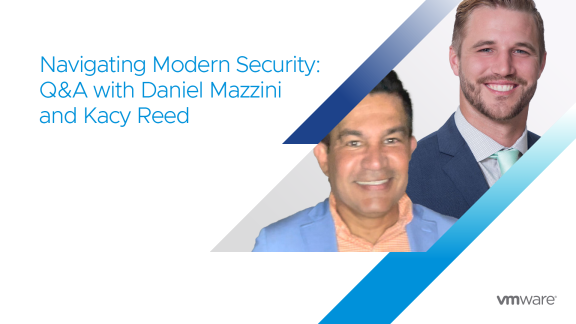Software is transforming today’s businesses. Modern applications are playing a huge role in business innovation, transformation and faster services delivery. Today’s business models require modern applications to be dynamic and distributed on multiple clouds. Apps must be nimble to adapt to different compute platforms like containers, virtual machines and bare metal. To support these modern apps, a modern network infrastructure is required to secure connectivity and reliability across multiple clouds. Networks must be scalable and agile and provide a great end user application experience.
To enable businesses to create a network optimized for modern apps, VMware has released a new version of NSX built with modern apps and end-to-end security in mind. NSX Data Center (NSX-T) allows customers to take advantage of new networking and security features to support new business models and diverse use cases. Existing VMware NSX for vSphere (NSX-V) customers can achieve greater business agility and superior network and application performance by migrating to NSX-T. Besides the new features of NSX-T, customers are encouraged to migrate to NSX-T since NSX-V reached the End of General Support (EOS) in January 2022 and will reach the End of Technical Support in January 2023. Customers need to act quickly with their NSX-V to NSX-T migration. In this article, we will look at the NSX-V to NSX-T migration use case, benefits, challenges and customer journey and how VMware Professional Services’ data center migration services can support you along the way.
Reasons to migrate from NSX-V to NSX-T
VMware built NSX-T with modern network requirements in mind. VMware NSX-T was built from the ground up for hybrid cloud and was specifically designed to ensure networks can handle changes in the application landscapes and security requirements. Protection against evolving sophisticated network security threats was also a priority. NSX-T focuses on providing networking, security, automation and operational simplicity for emerging application frameworks and architectures that have heterogeneous endpoint environments and technology stacks.
NSX-T Data Center supports cloud-native applications, bare-metal workloads, multi-hypervisor environments, public clouds and multiple clouds. NSX-T provides an agile software-defined infrastructure to build cloud-native application environments. NSX-T Data Center is designed for management, operation and consumption by development organizations. NSX-T Data Center allows IT teams and development teams to select the technologies best suited for their applications.
The key benefits of NSX-T includes the following:
- Improved scale, security and simplified operations.
- Best-in-class security and superior protection against malware and ransomware with great features like NSX Distributed Firewall, NSX Distributed IDS/IPS, NSX Network Detection and Response, Network Traffic Analysis and NSX Intelligence
- Advanced networking for multiple on-prem private clouds with centralized network operations using NSX Federation
- Advanced Container Networking, micro-segmentation for microservices and cross-platform visibility
- Simplified networking and security automation
Challenges with NSX-T adoption
NSX-T is substantially different than NSX-V. As such, migrating from NSX-V to NSX-T is not as simple as installing a patch or doing a minor upgrade. Network administrators must thoroughly analyze their current network to determine the requirements to migrate successfully.
The most common customer migration challenges are:
- Assessing current network topology and security services
- Gaining visibility into network and security complexities and dependencies
- Creating and defining a Migration Plan.
- Determining the upgrade sequencing and execution strategy
- Managing an extensive number of configurations and workloads
- Migrating multiple distributed firewall rules
- Minimizing downtime and data loss
- Maintaining data security during and after the migration
- Determining the resources and time to plan and execute the migration
- Developing the required skills and expertise
- Validating the right migration path and how to execute it
- Utilizing the right automation tools
- Integrating existing third-party products and services after the migration
The migration journey
Migrating from NSX-V to NSX-T (NSX V2T) does not have to be hard, but it is not something that should be taken lightly either. A network needs to be fully analyzed to be sure the proper hardware and configuration are in place to support the newly deployed NSX-T workloads. As with most things in networking, a little planning can go a long way to ensuring the long-term success of a project. VMware Professional Services can help you with the migration journey.
Organizations engaging VMware Professional Services and our Master Services Competencies (MSC) partners start the migration process with an NSX V2T Migration Assessment Service. This transition assessment evaluates the existing VMware NSX-V deployment and determines the future VMware NSX-T desired state. The service objective is to assess the customer’s environment, determine readiness for the migration path, provide a high-level overview of requirements and outline the process flow.
VMware Professional Services will review your current VMware NSX-V infrastructure by looking at key parameters and features such as the following:
- Number of data center/sites and hosts
- Networking services for containers, modern apps, cloud-native apps,
- Security services, distributed firewalling, and micro-segmentation
- VMware products/software in place (e.g., vRealize Automation, VMware Cloud Foundation, VMware Cloud Director, VMware Integrated OpenStack)
- Third-party products and services
- Features in use, like NAT (network address translation), BGP (border gateway protocol), OSPF (open shortest path first), static routing, load balancing, north-south/east-west firewall rules, and current network topologies
The VMware Professional Services team will discuss with you the relevant use cases for your network deployment such as supporting Kubernetes and container networking, networking and security automation, network detection and response against advanced threats, centralized policy management, securing VDI (virtualized desktop infrastructure), disaster recovery, micro-segmentation, IDS/IPS, moving workloads to/from the public cloud, networking and security analytics, among others.
The Assessment Service is delivered in three phases:
- Discovery. Gathering key details about your network and work environment
- Analyzing and planning. Evaluating current policies to identify what you need to migrate and the best way to do so
- Summary report of assessment. A document outlining the previous two steps and a migration strategy recommendation
After completion of the NSX V2T Migration Assessment Service, you will have a complete list of:
- Collected network and security data from the environment
- Migration requirements and potential risks
- Recommended hardware expansion plans (if required)
- Migration strategy recommendation
- Recommendations for migration of tooling supported features
- Recommendations for tooling unsupported features
- Recommendations for workload migrations
After the assessment, VMware Professional Services can help with NSX V2T Migration Execution.Based on the assessment results, VMware Professional Services will sit down with you to plan and review different NSX-V to NSX-T migration approaches: coexist, in-place, or lift-and-shift. For a detailed explanation of these different migration approaches and tools available for migration view our detailed NSX-T Data Center Migration Guide. No matter what strategy you choose for the migration, the necessary high-level steps are as follows:
- Review differences between NSX-V and the new NSX-T environment
- Create and review migration approach and rollback plan
- Review workloads, firewall rules and load balancing configuration to migrate
- Design and deploy NSX-T environment
- Import existing configuration from NSX-V
- Apply configuration and network topology to the NSX-T target environment
- Integrate VMware products and third-party systems
- Test and validate cutover
- Clean up (delete and remove old configurations)
- Transfer information
Depending on how you want to proceed with your migration, there are a few different NSX-V to NSX-T migrations engagement models you can use:
- Customer led and executed. With this approach, you can use the Migration Coordinator Tool and/or VMware NSX Migration for VMware Cloud Director to migrate from NSX-V to NSX-T in a VMware Cloud Director environment without the assistance of VMware on the actual migration, but you can get VMware Technical support on any tools you use. If you opt for this approach, it is highly recommended you have NSX-V to NSX-T migration training (to learn more about VMware training and certification visit VMware Learning) and high-level skills in networking and security.
- Engaging VMware Professional Services and our Master Services Competencies (MSC) partners: Please contact your VMware sales representative for NSX-V to NSX-T Migration Professional Services Offering. Our service portfolio includes multiple NSX-V to NSX-T services to support our customers during the journey.
By engaging with VMware Professional Service and MSC partners, you know that you are getting:
- A proven and tested migration methodology following VMware best practices
- A detailed migration and rollback plan including the level of effort, potential risks, and pre and post-migration tasks.
- A consistent migration deployment across multiple datacenters/sites.
- A successful migration of existing workloads that is as seamless as possible.
- Quick and secure migration of existing load balancers
- Successful migration of existing policies and firewall rules
- Reduced risk and complexity
- Faster migration times.
- Completed transfer of information
Next steps and additional resources
VMware NSX-T is a powerful tool, enabling IT managers to complete their transformation to a secure, multi-cloud network with complete support for containers and modern apps. To learn more about NSX-T, check out some of the links below. Or if you are ready to start your transformation journey, contact your VMware Professional Services team today.
- VMware NSX Product Page
- VMware Networking Professional Services website
- NSX-V to NSX-T Migration website
- NSX-T 3.2 Release Notes
- Download NSX-T 3.2
- NSX Hands-on Lab
VMware Professional Services has completed hundreds of migration projects and would love to help you with yours.





